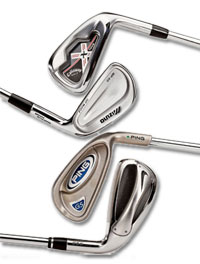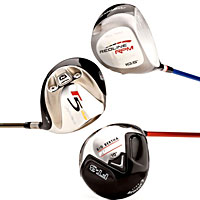Are all these golf club fitting choices still confusing? Here’s some set recommendations for various swing speeds to try and help you get started. These are only recommendations but should help you understand the variables that effect getting fit and choosing the right clubs. As you learn more about YOUR game you’ll be ready to take your fitting to the next level.
Iron Head Categories
Super Game Improvement (SGI)
Perimeter weighted, oversized, large offset, very wide sole, very thick top-line, low center of gravity
Game Improvement (GI)
Perimeter weighted, slightly oversized, medium offset, wide sole, thick top-line, low center of gravity
Players Clubs (P)
Some perimeter weighting usually in the longer clubs, slightly oversized, minimal offset, average sole, thin top-line, mid center of gravity
How swing speed effects set configuration and fitting requirements
| Driver Carry Distance | Swing Speed | Shaft Flex | Iron Head Type | Shaft Type | Iron Set | Driver Loft | Wood Set | Hybrid Set |
| 125-150 | 65-75 | L | SGI | G (all) | 7-SW | 14-15 | 1,5,7,9,11 | 4,5,6 |
| 150-175 | 75-85 | A | SGI | G (all) | 6-SW | 13-14 | 1,3,5,7 | 3,4,5 |
| 175-200 | 85-95 | R | GI | G | 5-SW | 12_13 | 1,3,5,7 | 3,4 |
| 200-225 | 95-100 | F | GI | G & S* | 5-SW | 11-12 | 1,3,5,7 | 3,4 |
| 225-250 | 100-110 | S | GI | G & S* | 4-LW | 10-11 | 1,3,5 | 2,3 |
| 250-275 | 110-125 | S | GI, P | G & S* | 4-LW | 9-11 | 1,3,5 | 2,3 |
| 275+ | 125+ | X | P | G & S* | 3-LW | 8-10 | 1,3 | 2 |
| * graphite in woods, steel in irons | LW=lob wedge |
Legend:
Shafts
L-ladies, A-amatuer, R-regular, F-firm, S-stiff, X-extra stiff
G-graphite, S-steel
Iron Type
SGI-Super Game Improvement
GI-Game Improvement
P-Players clubs
As you can see from above, your swing speed is the key factor in determining the correct shaft and shaft flex. It’s also a big factor in choosing your club set makeup. Golfers with slower swing speeds should carry more woods and hyprids in their bags.
If you are a beginner or play very seldom, then choosing some extra forgiveness is also a good idea. Remember, the shorter the club and the more loft the easier it is to hit in most cases.
Driver Head Variables
Along with your putter the driver is the most important club in your bag. Making sure you have the right driver is critical for good golf.
But many players choose their driver based on what their favorite pro plays or just take what the salesperson gives them. Of course the salesperson may be correct but wouldn’t it be better to understand driver fitting yourself to make sure you are being fit correctly?
Driver fitting variables…
- Head size (usually 400 to 460 CC these days – bigger means larger sweet spot)
- Lloft (ranges from 9-16 degrees and effects launch angle)
- Face angle to create different ball flights (draw or fade)
- Shaft length (standard men’s length is about 46″)
- Shaft flex (stiffer the faster you swing)
- Shaft kick point (effect height of shot)
- Weight distribution to create different ball flights (high-low, left-right)
To get properly fit for your driver you do need a Launch Monitor. This is a Doppler radar device that follows the ball after it comes off the clubhead and reports the specifics of ball flight. The golfer’s club head speed, ball speed, angle of approach, path, face angle, and side spin are measured. This launch monitor data will reveal the proper launch angle, angle of decent, spin rate, carry distance, and amount of roll to maximize your overall distance and consistency.
For example, a player with 100 mph club head speed (driver) will have an optimal launch angle of 12-13.5 degrees with an angle of decent goal of 14 degrees to maximize his/her roll. The optimal spin rate will be around 3000 rpm.
So to make sure your driver has the right variables above here’s what the Launch Monitor is looking for…
- Clubhead speed
- Ball speed
- Launch Angle
- Spin Rate
Once you you know these variables then you can choose different loft and shaft variations to get as close as possible to to the optimum launch angle of 12-13 degrees and a spin rate of 3000 rpm. Sees it’s not so complicated.
Again you need a Launch Monitor and someone who can help you read the data correctly as you try different drivers.
» Learn more about drivers here.
Making Sure Your Fitting Is Right
So what happens if you get your clubs fitted for you but still feel they aren’t right? Choosing a supplier that provides a satisfaction guarantee and allows subsequent adjustments is always a good idea. You and your clubfitter may not get it right the first time.
Unfortunately, brand name clubs are not going to help you much here. Most adjustments are made at the factory and it may take many weeks to get adjustments made. Typically brand name online fitters do not allow for returns of custom clubs either.
Some clone online fitters allow clubs to be changed or returned within 30 days even after you’ve hit them. Pinemeadow and GigaGolf both offer that feature. If you can find someone who will work with you to get the right clubs for your game…well you better keep looking.
You might also be able to find a good local clubfitter who will work with you to fine tune your clubs. They’re not always easy to find. A good place to look is The Professional Clubmakers’ Society. They offer a ‘find a clubfitter’ service through their website. If you have a Golfsmith store in your area they do a great job of helping you get fit and will also assemble clubs for you. I just had a fitting when I bought my new driver, a Taylor Made Burner.
Do You Know About GolfWorks?
Another great resource for the details of clubfitting is GolfWorks. You may have seen its founder Ralph Maltby on The Golf Channel. His company takes a very scientific approach to golf clubs and has analyzed how the details of club design affect a golf shot. He goes beyond SGI, GI, and players clubs and has created something he calls the Maltby Playability Factor (MPF) which puts a number on the forgiveness of every golf club. He has tested many clubs going back many years and his book The Maltby Playability Factor: Book One – Irons by Ralph Maltby is a classic on the subject of clubfitting and playability.
Whether your fitting session is done in person by a quality clubfitter or you decide to use an online fitting system, getting the right clubs for you and your game is worth the time and effort. A well-fit set of clubs will not only improve your ball striking but will also help you enjoy the game more. There’s nothing like the feeling of a well hit shot and then watching your ball fly straight towards the target. After all, it’s why we play this great game.

